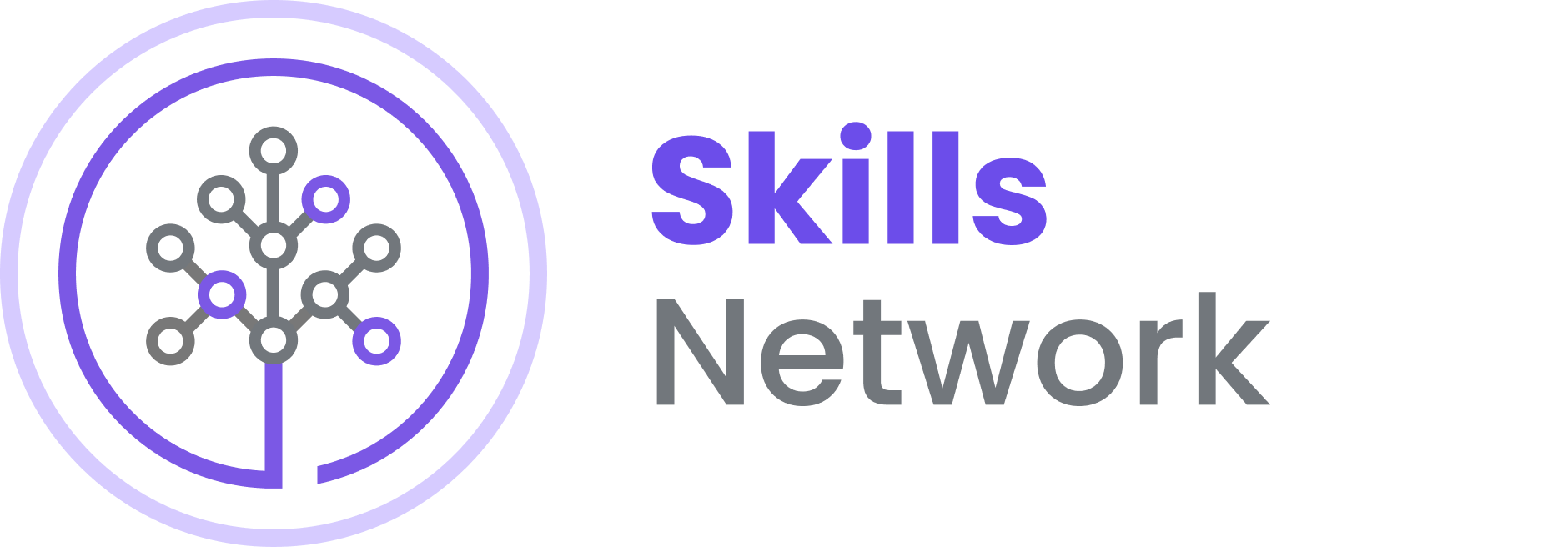Space X Falcon 9 First Stage Landing Prediction
Assignment: Machine Learning Prediction
Estimated time needed: 60 minutes
Space X advertises Falcon 9 rocket launches on its website with a cost of 62 million dollars; other providers cost upward of 165 million dollars each, much of the savings is because Space X can reuse the first stage. Therefore if we can determine if the first stage will land, we can determine the cost of a launch. This information can be used if an alternate company wants to bid against space X for a rocket launch. In this lab, you will create a machine learning pipeline to predict if the first stage will land given the data from the preceding labs.

Several examples of an unsuccessful landing are shown here:
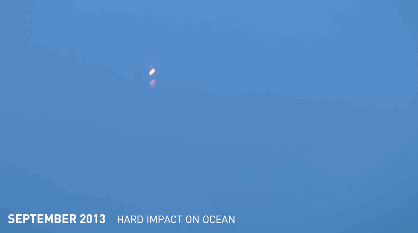
Most unsuccessful landings are planed. Space X; performs a controlled landing in the oceans.
Objectives
Perform exploratory Data Analysis and determine Training Labels
- create a column for the class
- Standardize the data
- Split into training data and test data
-Find best Hyperparameter for SVM, Classification Trees and Logistic Regression
- Find the method performs best using test data
Import Libraries and Define Auxiliary Functions
We will import the following libraries for the lab
# Pandas is a software library written for the Python programming language for data manipulation and analysis.
import pandas as pd
# NumPy is a library for the Python programming language, adding support for large, multi-dimensional arrays and matrices, along with a large collection of high-level mathematical functions to operate on these arrays
import numpy as np
# Matplotlib is a plotting library for python and pyplot gives us a MatLab like plotting framework. We will use this in our plotter function to plot data.
import matplotlib.pyplot as plt
#Seaborn is a Python data visualization library based on matplotlib. It provides a high-level interface for drawing attractive and informative statistical graphics
import seaborn as sns
# Preprocessing allows us to standarsize our data
from sklearn import preprocessing
# Allows us to split our data into training and testing data
from sklearn.model_selection import train_test_split
# Allows us to test parameters of classification algorithms and find the best one
from sklearn.model_selection import GridSearchCV
# Logistic Regression classification algorithm
from sklearn.linear_model import LogisticRegression
# Support Vector Machine classification algorithm
from sklearn.svm import SVC
# Decision Tree classification algorithm
from sklearn.tree import DecisionTreeClassifier
# K Nearest Neighbors classification algorithm
from sklearn.neighbors import KNeighborsClassifier
This function is to plot the confusion matrix.
def plot_confusion_matrix(y,y_predict):
"this function plots the confusion matrix"
from sklearn.metrics import confusion_matrix
cm = confusion_matrix(y, y_predict)
ax= plt.subplot()
sns.heatmap(cm, annot=True, ax = ax); #annot=True to annotate cells
ax.set_xlabel('Predicted labels')
ax.set_ylabel('True labels')
ax.set_title('Confusion Matrix');
ax.xaxis.set_ticklabels(['did not land', 'land']); ax.yaxis.set_ticklabels(['did not land', 'landed'])
Load the dataframe
Load the data
data = pd.read_csv("dataset_part_2.csv")
# If you were unable to complete the previous lab correctly you can uncomment and load this csv
# data = pd.read_csv('https://cf-courses-data.s3.us.cloud-object-storage.appdomain.cloud/IBMDeveloperSkillsNetwork-DS0701EN-SkillsNetwork/api/dataset_part_2.csv')
data.head()
| FlightNumber | Date | BoosterVersion | PayloadMass | Payload | Orbit | LaunchSite | Outcome | Flights | GridFins | Reused | Legs | LandingPad | Block | ReusedCount | Serial | Longitude | Latitude | Class | |
|---|---|---|---|---|---|---|---|---|---|---|---|---|---|---|---|---|---|---|---|
| 0 | 1 | 2010-06-04 | Falcon 9 | 6123.547647 | Dragon Qualification Unit | LEO | CCSFS SLC 40 | None None | 1 | False | False | False | NaN | 1.0 | 0 | B0003 | -80.577366 | 28.561857 | 0 |
| 1 | 2 | 2012-05-22 | Falcon 9 | 525.000000 | COTS Demo Flight 2 | LEO | CCSFS SLC 40 | None None | 1 | False | False | False | NaN | 1.0 | 0 | B0005 | -80.577366 | 28.561857 | 0 |
| 2 | 3 | 2013-03-01 | Falcon 9 | 677.000000 | CRS-2 | ISS | CCSFS SLC 40 | None None | 1 | False | False | False | NaN | 1.0 | 0 | B0007 | -80.577366 | 28.561857 | 0 |
| 3 | 4 | 2013-09-29 | Falcon 9 | 500.000000 | CASSIOPE | PO | VAFB SLC 4E | False Ocean | 1 | False | False | False | NaN | 1.0 | 0 | B1003 | -120.610829 | 34.632093 | 0 |
| 4 | 5 | 2013-12-03 | Falcon 9 | 3170.000000 | SES-8 | GTO | CCSFS SLC 40 | None None | 1 | False | False | False | NaN | 1.0 | 0 | B1004 | -80.577366 | 28.561857 | 0 |
X = pd.read_csv('dataset_part_3.csv')
# If you were unable to complete the previous lab correctly you can uncomment and load this csv
# X = pd.read_csv('https://cf-courses-data.s3.us.cloud-object-storage.appdomain.cloud/IBMDeveloperSkillsNetwork-DS0701EN-SkillsNetwork/api/dataset_part_3.csv')
X.head(10)
| FlightNumber | PayloadMass | Flights | GridFins | Reused | Legs | Block | ReusedCount | Orbit_ES-L1 | Orbit_GEO | ... | Serial_B1048 | Serial_B1049 | Serial_B1050 | Serial_B1051 | Serial_B1054 | Serial_B1056 | Serial_B1058 | Serial_B1059 | Serial_B1060 | Serial_B1062 | |
|---|---|---|---|---|---|---|---|---|---|---|---|---|---|---|---|---|---|---|---|---|---|
| 0 | 1 | 6123.547647 | 1 | False | False | False | 1.0 | 0 | 0 | 0 | ... | 0 | 0 | 0 | 0 | 0 | 0 | 0 | 0 | 0 | 0 |
| 1 | 2 | 525.000000 | 1 | False | False | False | 1.0 | 0 | 0 | 0 | ... | 0 | 0 | 0 | 0 | 0 | 0 | 0 | 0 | 0 | 0 |
| 2 | 3 | 677.000000 | 1 | False | False | False | 1.0 | 0 | 0 | 0 | ... | 0 | 0 | 0 | 0 | 0 | 0 | 0 | 0 | 0 | 0 |
| 3 | 4 | 500.000000 | 1 | False | False | False | 1.0 | 0 | 0 | 0 | ... | 0 | 0 | 0 | 0 | 0 | 0 | 0 | 0 | 0 | 0 |
| 4 | 5 | 3170.000000 | 1 | False | False | False | 1.0 | 0 | 0 | 0 | ... | 0 | 0 | 0 | 0 | 0 | 0 | 0 | 0 | 0 | 0 |
| 5 | 6 | 3325.000000 | 1 | False | False | False | 1.0 | 0 | 0 | 0 | ... | 0 | 0 | 0 | 0 | 0 | 0 | 0 | 0 | 0 | 0 |
| 6 | 7 | 2296.000000 | 1 | False | False | True | 1.0 | 0 | 0 | 0 | ... | 0 | 0 | 0 | 0 | 0 | 0 | 0 | 0 | 0 | 0 |
| 7 | 8 | 1316.000000 | 1 | False | False | True | 1.0 | 0 | 0 | 0 | ... | 0 | 0 | 0 | 0 | 0 | 0 | 0 | 0 | 0 | 0 |
| 8 | 9 | 4535.000000 | 1 | False | False | False | 1.0 | 0 | 0 | 0 | ... | 0 | 0 | 0 | 0 | 0 | 0 | 0 | 0 | 0 | 0 |
| 9 | 10 | 4428.000000 | 1 | False | False | False | 1.0 | 0 | 0 | 0 | ... | 0 | 0 | 0 | 0 | 0 | 0 | 0 | 0 | 0 | 0 |
10 rows × 80 columns
TASK 1
Create a NumPy array from the column Class in data, by applying the method to_numpy() then
assign it to the variable Y,make sure the output is a Pandas series (only one bracket df[‘name of column’]).
Y = data['Class'].to_numpy()
TASK 2
Standardize the data in X then reassign it to the variable X using the transform provided below.
# students get this
transform = preprocessing.StandardScaler()
X = transform.fit_transform(X)
We split the data into training and testing data using the function train_test_split. The training data is divided into validation data, a second set used for training data; then the models are trained and hyperparameters are selected using the function GridSearchCV.
TASK 3
Use the function train_test_split to split the data X and Y into training and test data. Set the parameter test_size to 0.2 and random_state to 2. The training data and test data should be assigned to the following labels.
X_train, X_test, Y_train, Y_test
X_train, X_test, Y_train, Y_test = train_test_split(X, Y, test_size = 0.2, random_state = 2)
we can see we only have 18 test samples.
Y_test.shape
(18,)
TASK 4
Create a logistic regression object then create a GridSearchCV object logreg_cv with cv = 10. Fit the object to find the best parameters from the dictionary parameters.
parameters ={'C':[0.01,0.1,1],
'penalty':['l2'],
'solver':['lbfgs']}
parameters ={"C":[0.01,0.1,1],'penalty':['l2'], 'solver':['lbfgs']}# l1 lasso l2 ridge
lr=LogisticRegression(max_iter=1000)
logreg_cv = GridSearchCV(lr, parameters)
logreg_cv.fit(X_train, Y_train)
GridSearchCV(estimator=LogisticRegression(max_iter=1000),
param_grid={'C': [0.01, 0.1, 1], 'penalty': ['l2'],
'solver': ['lbfgs']})In a Jupyter environment, please rerun this cell to show the HTML representation or trust the notebook. On GitHub, the HTML representation is unable to render, please try loading this page with nbviewer.org.
GridSearchCV(estimator=LogisticRegression(max_iter=1000),
param_grid={'C': [0.01, 0.1, 1], 'penalty': ['l2'],
'solver': ['lbfgs']})LogisticRegression(max_iter=1000)
LogisticRegression(max_iter=1000)
We output the GridSearchCV object for logistic regression. We display the best parameters using the data attribute best_params\_ and the accuracy on the validation data using the data attribute best_score\_.
print("tuned hpyerparameters :(best parameters) ",logreg_cv.best_params_)
print("accuracy :",logreg_cv.best_score_)
tuned hpyerparameters :(best parameters) {'C': 0.1, 'penalty': 'l2', 'solver': 'lbfgs'}
accuracy : 0.8342857142857142
TASK 5
Calculate the accuracy on the test data using the method score:
score_logreg = logreg_cv.best_score_
print("the best model score: %.3f" % score_logreg)
the best model score: 0.834
Lets look at the confusion matrix:
yhat=logreg_cv.predict(X_test)
plot_confusion_matrix(Y_test,yhat)
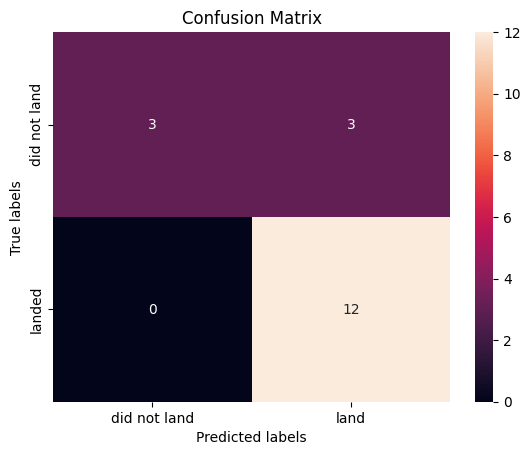
Examining the confusion matrix, we see that logistic regression can distinguish between the different classes. We see that the major problem is false positives.
TASK 6
Create a support vector machine object then create a GridSearchCV object svm_cv with cv - 10. Fit the object to find the best parameters from the dictionary parameters.
parameters = {'kernel':('linear','rbf', 'sigmoid'),
'C': np.logspace(-3, 3, 5),
'gamma':np.logspace(-3, 3, 5)}
svm = SVC(cache_size=7000)
svm_cv = GridSearchCV(svm, parameters)
svm_cv.fit(X_train, Y_train)
GridSearchCV(estimator=SVC(cache_size=7000),
param_grid={'C': array([1.00000000e-03, 3.16227766e-02, 1.00000000e+00, 3.16227766e+01,
1.00000000e+03]),
'gamma': array([1.00000000e-03, 3.16227766e-02, 1.00000000e+00, 3.16227766e+01,
1.00000000e+03]),
'kernel': ('linear', 'rbf', 'sigmoid')})In a Jupyter environment, please rerun this cell to show the HTML representation or trust the notebook. On GitHub, the HTML representation is unable to render, please try loading this page with nbviewer.org.
GridSearchCV(estimator=SVC(cache_size=7000),
param_grid={'C': array([1.00000000e-03, 3.16227766e-02, 1.00000000e+00, 3.16227766e+01,
1.00000000e+03]),
'gamma': array([1.00000000e-03, 3.16227766e-02, 1.00000000e+00, 3.16227766e+01,
1.00000000e+03]),
'kernel': ('linear', 'rbf', 'sigmoid')})SVC(cache_size=7000)
SVC(cache_size=7000)
print("tuned hpyerparameters :(best parameters) ",svm_cv.best_params_)
print("accuracy :",svm_cv.best_score_)
tuned hpyerparameters :(best parameters) {'C': 0.03162277660168379, 'gamma': 0.001, 'kernel': 'linear'}
accuracy : 0.8485714285714285
TASK 7
Calculate the accuracy on the test data using the method score:
score_svm = svm_cv.best_score_
print("the best model score: %.3f" % score_svm)
the best model score: 0.849
We can plot the confusion matrix
yhat=svm_cv.predict(X_test)
plot_confusion_matrix(Y_test,yhat)
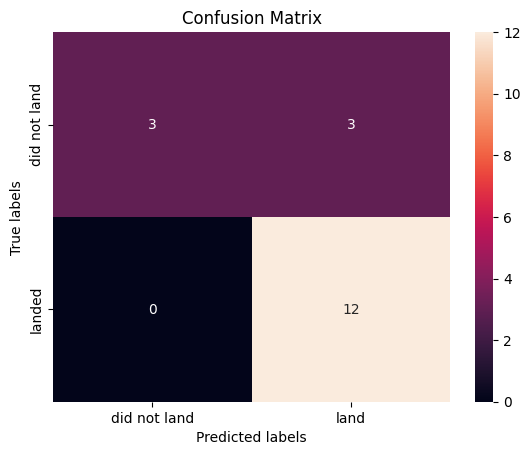
TASK 8
Create a decision tree classifier object then create a GridSearchCV object tree_cv with cv = 10. Fit the object to find the best parameters from the dictionary parameters.
parameters = {'criterion': ['gini', 'entropy'],
'splitter': ['best', 'random'],
'max_depth': [2*n for n in range(1,10)],
'max_features': ['sqrt'],#'auto',
'min_samples_leaf': [1, 2, 4],
'min_samples_split': [2, 5, 10]}
tree = DecisionTreeClassifier()
tree_cv = GridSearchCV(tree, parameters)
tree_cv.fit(X_train, Y_train)
GridSearchCV(estimator=DecisionTreeClassifier(),
param_grid={'criterion': ['gini', 'entropy'],
'max_depth': [2, 4, 6, 8, 10, 12, 14, 16, 18],
'max_features': ['sqrt'],
'min_samples_leaf': [1, 2, 4],
'min_samples_split': [2, 5, 10],
'splitter': ['best', 'random']})In a Jupyter environment, please rerun this cell to show the HTML representation or trust the notebook. On GitHub, the HTML representation is unable to render, please try loading this page with nbviewer.org.
GridSearchCV(estimator=DecisionTreeClassifier(),
param_grid={'criterion': ['gini', 'entropy'],
'max_depth': [2, 4, 6, 8, 10, 12, 14, 16, 18],
'max_features': ['sqrt'],
'min_samples_leaf': [1, 2, 4],
'min_samples_split': [2, 5, 10],
'splitter': ['best', 'random']})DecisionTreeClassifier()
DecisionTreeClassifier()
print("tuned hpyerparameters :(best parameters) ",tree_cv.best_params_)
print("accuracy :",tree_cv.best_score_)
tuned hpyerparameters :(best parameters) {'criterion': 'gini', 'max_depth': 4, 'max_features': 'sqrt', 'min_samples_leaf': 1, 'min_samples_split': 5, 'splitter': 'random'}
accuracy : 0.8619047619047621
TASK 9
Calculate the accuracy of tree_cv on the test data using the method score:
score_tree = tree_cv.best_score_
print("the best model score: %.3f" % score_tree)
the best model score: 0.862
We can plot the confusion matrix
yhat = tree_cv.predict(X_test)
plot_confusion_matrix(Y_test,yhat)
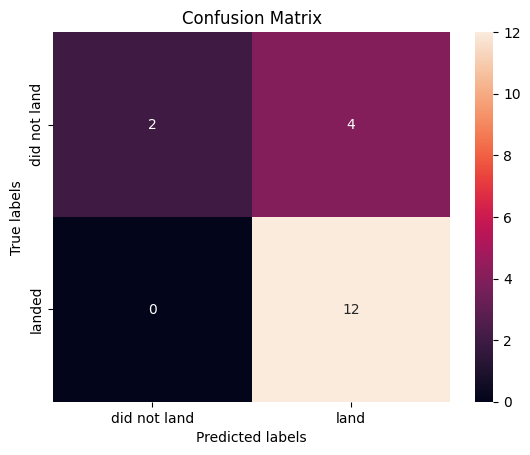
TASK 10
Create a k nearest neighbors object then create a GridSearchCV object knn_cv with cv = 10. Fit the object to find the best parameters from the dictionary parameters.
parameters = {'n_neighbors': [1, 2, 3, 4, 5, 6, 7, 8, 9, 10],
'algorithm': ['auto', 'ball_tree', 'kd_tree', 'brute'],
'p': [1,2]}
KNN = KNeighborsClassifier()
knn_cv = GridSearchCV(KNN, parameters)
knn_cv.fit(X_train, Y_train)
print("model score: %.3f" % knn_cv.score(X_test, Y_test))
model score: 0.833
print("tuned hpyerparameters :(best parameters) ",knn_cv.best_params_)
print("accuracy :",knn_cv.best_score_)
tuned hpyerparameters :(best parameters) {'algorithm': 'auto', 'n_neighbors': 10, 'p': 1}
accuracy : 0.8190476190476191
TASK 11
Calculate the accuracy of tree_cv on the test data using the method score:
score_knn = knn_cv.best_score_
print("the best model score: %.3f" % score_knn)
the best model score: 0.819
We can plot the confusion matrix
yhat = knn_cv.predict(X_test)
plot_confusion_matrix(Y_test,yhat)
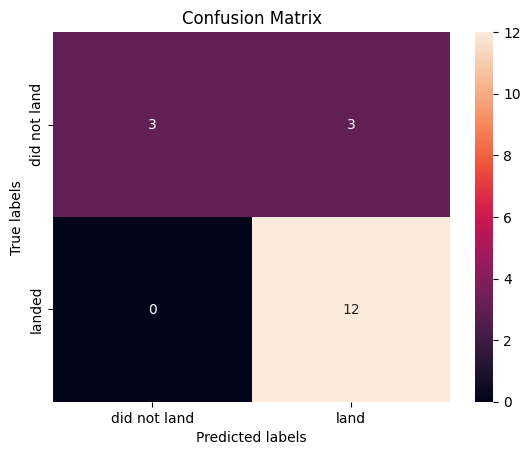
TASK 12
Find the method performs best:
scores = {'Logistic Regression': score_logreg,
'SVM':score_svm,
'Decision Tree':score_tree,
'KNN':score_knn
}
best_score = max(scores, key=scores.get)
print("The method performs best is %s with score: %.3f" % (best_score, scores[best_score]))
print("\nScores for other methods:")
for key, value in scores.items():
print("For %s score is %.3f" % (key, value))
The method performs best is Decision Tree with score: 0.862
Scores for other methods:
For Logistic Regression score is 0.834
For SVM score is 0.849
For Decision Tree score is 0.862
For KNN score is 0.819
scores_data = pd.DataFrame({'Methods':list(scores.keys()),
'Score':list(scores.values())})
sns.barplot(x='Methods', y="Score", data=scores_data)
plt.xlabel("ML Models",fontsize=10)
plt.ylabel("Score",fontsize=10)
plt.show()
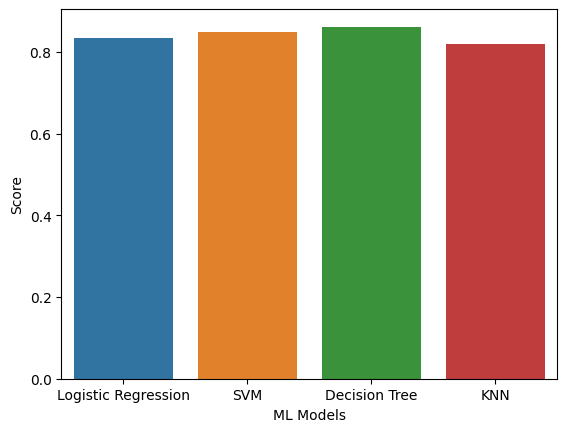
Authors
Joseph Santarcangelo has a PhD in Electrical Engineering, his research focused on using machine learning, signal processing, and computer vision to determine how videos impact human cognition. Joseph has been working for IBM since he completed his PhD.
Change Log
| Date (YYYY-MM-DD) | Version | Changed By | Change Description |
|---|---|---|---|
| 2021-08-31 | 1.1 | Lakshmi Holla | Modified markdown |
| 2020-09-20 | 1.0 | Joseph | Modified Multiple Areas |
Copyright © 2020 IBM Corporation. All rights reserved.
